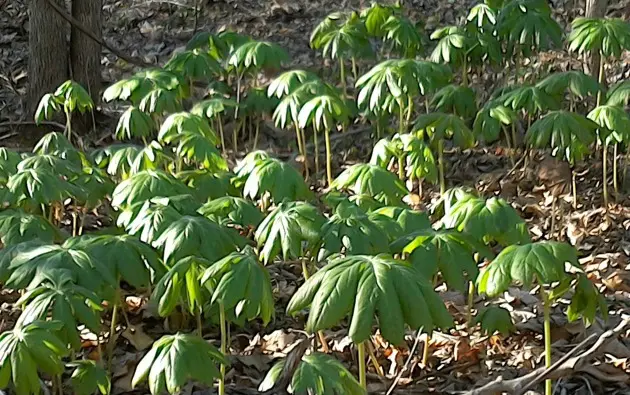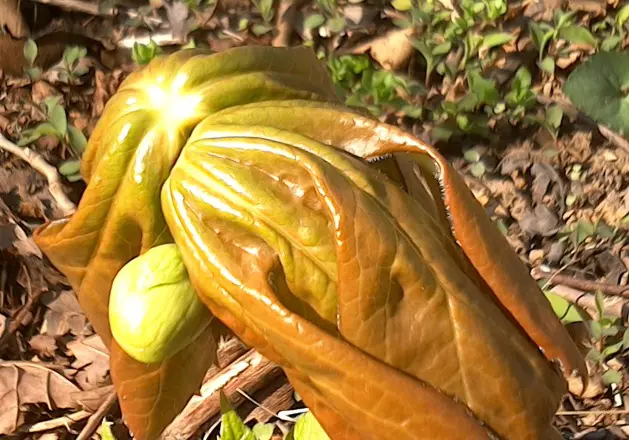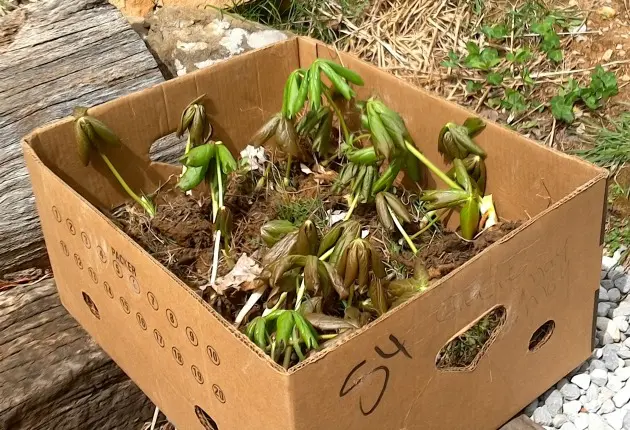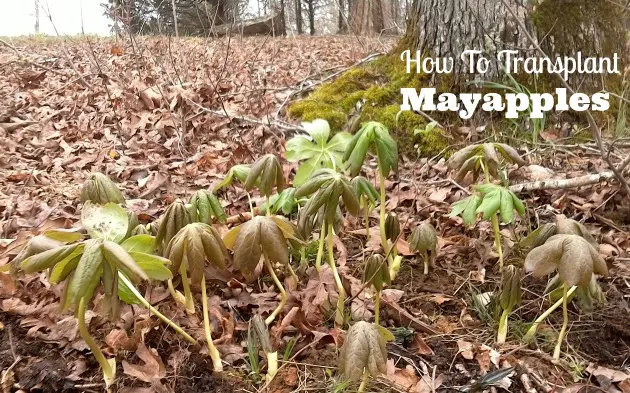Whether you are creating edible landscaping for your homestead or you just enjoy native plants, mayapples are a great choice. Mayapples are fairly easy to grow and this edible wild food can be found for in large quantities right out in the woods. First, I will tell you some general information about the mayapple plant. For example, it is important to know that mayapple fruit is poisonous when eaten green. Here is how to transplant mayapples to a place where the wildlife is less likely to grab them up before you can enjoy them.
What are Mayapples?
First of all, many of you may be wondering, “What are Mayapples?” Well, mayapples (Podophyllum peltatum) are a perennial woodland plant that grow wild in the shade of deciduous trees. The mayapple plants have green, waxy-looking, large leaves that can grow up to a foot wide. Each plant typically has one or two large, lobed leaves, with each leaf divided into five to nine lobes, creating a hand-like shape. The leaves are bright green, and their shape and size provide significant ground cover in shaded woodlands.Another common name you may have heard for them is American mandrake or ground lemon. They usually grow in large colonies and spread through their underground rhizome root system.
Where Does Mayapple Grow?
You can find the mayapple plant right here in the woods in Tennessee. According to the University of Wisconsin Horticulture Division, they grow in the wild “widespread across most of eastern North America south to Texas in zones 3 to 8.”
The native mayapple plant is a pretty indicator that it is spring as you see the herbaceous shoots of the mayapple plant “thrusting themselves upward through the forest floor like unopened umbrellas” as Mother Earth Living says. Extremely hardy in Zones 4 to 9, this eastern North American native is excellent for naturalizing in woodland settings but the foliage does go dormant in summer.
Are Mayapples Poisonous or Are Mayapples Edible?
The mayapple plant itself should never be eaten. However, it is safe to eat the mayapple fruit when it is fully ripened. The University of Wisconsin Horticulture Division states that, “All the parts of the plant, except the fruit, contain podophyllotoxin which is highly toxic if consumed, but was used by Native Americans for a variety of medicinal purposes.” They also note that the 1½-2 inch long fruits (but not the seeds) are edible when ripe. Mayapples are most often used mayapple jelly.
Mayapple Fruit
Mayapple is also known as the “Indian Apple.” The mature may apple fruits are edible and yummy, however, mayapple fruit is poisonous to eat when green. Do not try to eat may apples until they are yellow and soft and you have had help from an expert identifying the plant and state of the fruit. Do not eat the seeds and do not eat unripe fruit. What do mayapples look like? Mature fruits will be yellow and beginning to shrivel. They are about the size of a small lemon.
In early summer, usually the month of May, Mayapples makes a white, waxy, cup-shaped flower. By late summer, this white flower develops into a small, lemon-yellow or greenish fruit, about the size of a large grape, known as the “mayapple.” The yellow fruits are edible and pleasing to taste. This is the reason the wild life such as squirrels usually beat us to harvesting the fruits. That is why transplanting mayapples and having them grow right near your house or at the edge of the woods, offers a better chance at getting ripe fruit before the local wildlife does.
Rodale’s Encyclopedia of Organic Gardening explains, ” Mayapple is an interesting plant for the wild wood garden, growing about 18 inches in in rich, well drained woods soil. It will do well in full or partial shade, and appreciates an annual feeding of bone meal. A winter mulch of hardwood leaves is recommended.”
How To Transplant Mayapples
Do you have a patch of woods next to where you live? You might consider transplanting some mayapple plants that grow in the wild where you live. You can propagate this wild edible fruit for easy harvesting, conveniently close to your house and it is a great addition to any edible homestead collection. This woodland plant has a creeping rootstock, and is easily propagated by dividing them. Now, early spring is the season to transplant mayapples.
When to transplant mayapple: The early spring is a great time to spot mayapples while the foliage is around them is still suppressed, and lagging behind. You may spot them growing in the woods along your road, or in ditches, drain ditches and other shaded places alongside the road.
I was able to find some mayapple plants in a ditch on the side of the road in my neighborhood, and I gathered the young shoots which were newly emerged. Then I transferred them to a wooded and shady area right next to the house. I transplanted the mayapples on a cool day in several clusters. They “took” very well. Their little stems perked up nicely the next morning. Just make sure you water them for the first couple of days.
Here are my instructions for for transplanting mayapples into your own woodland gardens. If you need help identifying the mayapple plant, check Wild Wood Survival.
TRANSPLANTING MAYAPPLES:
1. First make sure you have some mayapples growing relatively close to where you live, so you can transport them pretty quickly to avoid lots of wilting of your new transplants.
2.Prepare your chosen spot to transfer. I chose close to the house in the shade of some woodland oak trees.
3. Ruffle the dirt and nature’s mulch up a little, so that it is loose and accommodating to snuggling some fresh new shoots down into.
4. Grab your garden gloves, a little trowel, and a cardboard box for carrying them.
5. Put on your garden gloves and dig up the newly emerging Mayapples being sure to keep their tubers and root clusters in tact with the dirt around them. Gather the Mayapple plants and put them in the cardboard box for easy transport.
6. Dig little holes for the Mayapple “starts” (young shoots) in your prepared spot in your new “Woodland Garden.” The holes just need to be big enough to set the roots below ground level.
7. Place soil back around them pressing down to get out the air.
8. Water the mayapples. Water them again the next day.
That is how you transplant mayapples! They should be all set to grow.
I hope you enjoyed my mayapples images. This is what my mayapples looked like the second day after I transplanted them into my native plant garden. You can see their umbrella-like leaves opened right back up. They are an herbaceous perennial so they will return year after year. They grow easily here in the Eastern United States and can do well in full shade to light shade.
Conclusion
Mayapples are unique, fascinating plants with a rich history in North American woodlands. Known for their umbrella-like leaves and small, pale blooms, they thrive in shaded, moist environments and play a distinct role in their ecosystems. While the fruit of the mayapple is edible when fully ripe, care should be taken, as other parts of the plant are toxic if ingested. Medicinally, mayapples have been used in traditional remedies, and their extract, podophyllotoxin, is valuable in modern medicine. With both practical and cultural significance, the mayapple highlights the diverse potential of native flora.
Please note that mayapple fruit is poisonous when eaten green. Do you love finding new edible wild foods too? Do you think you will transplant mayapples to increase your edible landscaping?
You may also enjoy this article on transplanting daylilies as part of your edible landscaping!
Related Post:
Native Plants Landscaping- Benefits And Tips





Linda Kinsman says
How cool! I’ve never heard of may-apples. I think I’ll take a walk in our back acreage again and look for some!
Rick says
Can mayapples be dug and potted for transplanting later?
Scarlet says
Sure. However, every time you mess with their roots they are vulnerable so less is better and easier.